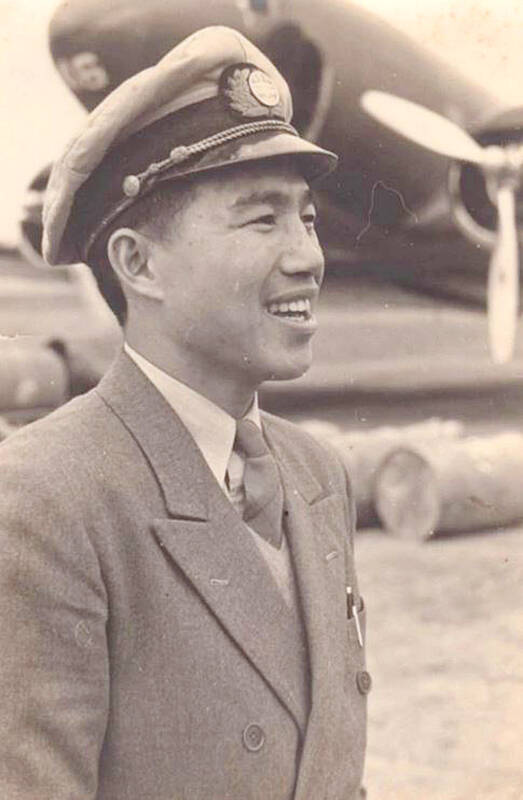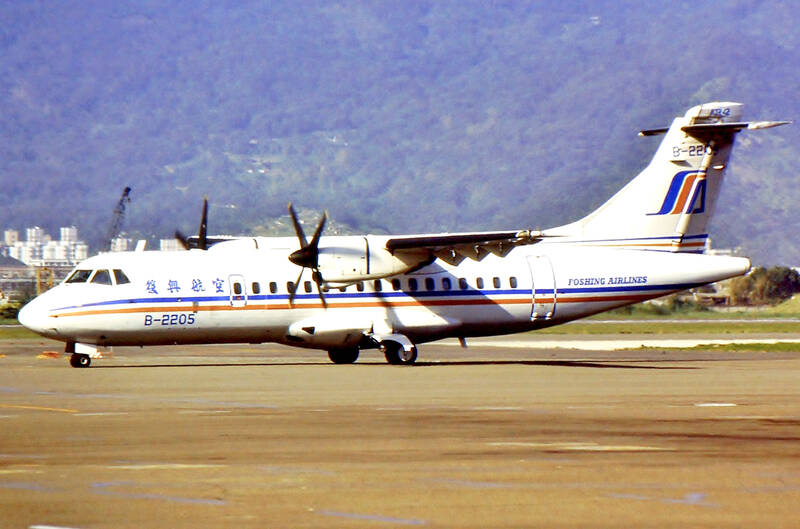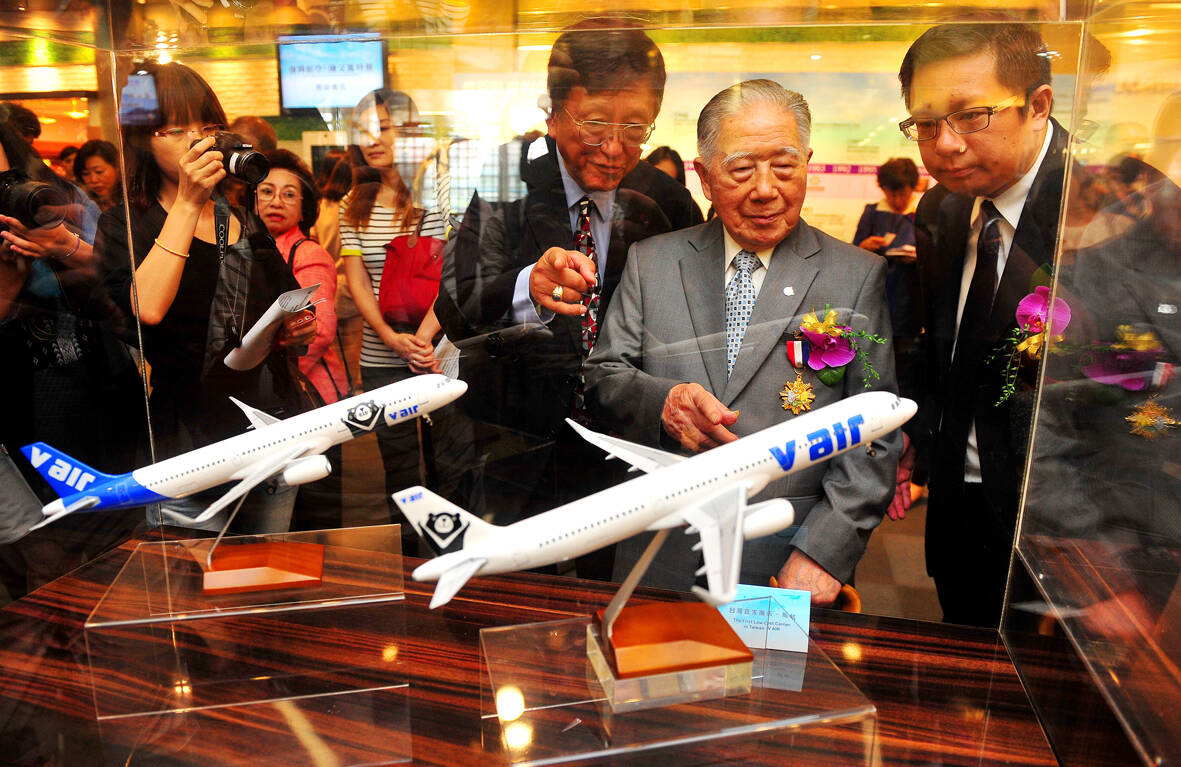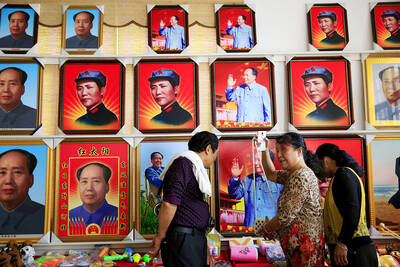May 20 to May 26
The two American HU-16 seaplanes hovered helplessly above the roaring waves, unable to save their seven comrades who had parachuted into the Pacific Ocean after their plane malfunctioned.
As they were discussing the next plan of action over the airwaves, a Taiwanese plane overheard the conversation and told them to contact Chin Moon Fun (陳文寬) — “because that guy can land a plane on any water surface!”

Taipei Times file photo
On March 18, 1954, Chin, who co-owned Foshing Airlines (復興航空, renamed TransAsia in 1992), hurriedly flew one of the company’s two amphibious PBY Catalina planes to the scene. Even though the PBY was inferior to the HU-16, Chin managed to land the plane on the first try by bouncing off a wave. However, a few screws had fallen out due to the impact, and water began seeping in. Instead of aborting the mission, Chin plugged the holes with pencils and continued the rescue effort, which took a total of four hours.
Taking off from the violent seas was much harder. After several tries, Chin asked a US warship that had arrived to break the waves for him, and using the Diaoyutai Islands (釣魚台) to block the wind, the PBY left the waters and flew to safety.
Spanning 50 years from the US to China to Taiwan, Chin’s storied aviation career often saw him at the forefront of historical events. The Republic of China military held his skills in great esteem, and he was asked to transport party leader Chiang Kai-shek (蔣介石) and other government bigwigs on countless occasions.

Photo courtesy of Wikimedia Commons
Although it was Taiwan’s first private civil airline, Foshing Airlines was barely known for its commercial flights under Chin, making most of its revenue through charter missions for the government, as well as ground operations and catering meals for international flights.
Chin sold the company in 1983 at the age of 70, and after making his final flight he relocated to the US where he lived to 110 years old.
DREAMS OF FLYING

Photo: Chien Jung-fong, Taipei Times
Chin was born in 1914 in Guangdong Province. His Chinese-American father returned to the US before his birth, but came back for him 10 years later.
While waiting to pass immigration in Seattle, Chin saw an “odd looking ship with horizontal sails on both sides” in the harbor. He watched it speed up and was shocked when it suddenly took flight. He was mesmerized, writes Wang Li-chen (王立楨) in Chin’s biography.
They made their way to his father’s hometown of Baltimore, where Chin studied to become a car mechanic. Chin saw an ad for an aviation school at a bus stop one day, but his father refused to let him fly, as accidents were frequent in those days. Chin enrolled as a mechanic at the school at first, but his cousin, a respected leader in the Baltimore Chinese community, persuaded his father to let him give it a try.
“If he wants to die so badly, just let him do it,” his father reportedly said, and paid for his tuition — which wasn’t a small sum in those days.
On Aug. 23, 1932, Chin passed his commercial license exam. He long remembered what the examiner told him: “The sky is yours now, go enjoy it!”
CHINA DAYS
Chin returned to China in 1933 as a mechanic and pilot for Pan American Airways’ newly acquired Chinese branch, China National Aviation Corporation.
His first flight as captain was on May 16, 1936, flying from Chongqing to Chengdu. The Japanese invaded Shanghai on Aug. 13, 1937, and Chin helped relocate the company’s planes to Hankou amid enemy fire.
Chin continued to fly throughout World War II, logging more than 10,000 flight hours and helping the ROC military out with numerous operations, including evacuating government officials and other important figures from warzones.
One of Chin’s best known feats was transporting US general Jimmy Doolittle from Chongqing to Calcutta in 1942, just a month after Doolittle led the first US air raid on Japan.
Before arriving at the pit stop in Myitkyina in today’s Myanmar, they heard that Japanese forces were about to capture the town. Chin landed anyway and crammed more than 70 evacuees into the 21-seater. Doolittle tossed everyone’s luggage out of the plane, and Chin climbed over their heads to the cockpit where they made it to India.
After World War II, Chin joined Central Air Transport Co, quickly building up the fleet and turning it into a lucrative business as deputy general manager. As the Chinese Civil War worsened, Chin flew to Taiwan in August 1949 to see if the company could move there. The authorities told him that due to the massive relocation of the ROC Air Force to Taiwan, the only airport available for him was a dilapidated one in Yilan that was practically unusable.
It didn’t matter anyway; as soon as Chin returned to China, Central Air Transport president Chen Cho-lin (陳卓林) informed Chin of his plans to join the Chinese communists in Beijing. Chin turned down multiple requests to go with them, saying that he preferred to observe the situation first before joining any side, retreating to his home in Hong Kong.
MILITARY MISSIONS
Chin spent the following year relaxing and working on his model train hobby. He did not want to join the communists, but Taiwan was not exactly an option either. He pondered returning to the US.
One day, an old buddy who had joined the Chinese Nationalist Party’s (KMT) intelligence agency paid Chin a visit. They wanted him to set up a civilian airline in Taiwan and help the military fly secret missions to China. These planes had to land on the water since the communists controlled most of the coast, and Chen had gained much expertise in this area during World War II.
On May 21, 1951, Chin launched Foshing Airlines with Tai An-kuo (戴安國, former Civil Aviation Administration chief and Chiang Kai-shek’s godson) and former Central Air Transport colleague Tsai Ke-fei (蔡克非).
The airline struggled to attract commercial customers, with only its Taipei-Hualien route seeing significant ridership. The military contracted Foshing’s two PBY planes to transport officers to the islands the Chinese Nationalist Party (KMT) still held along the coast, of which only Kinmen had an airport. They supplemented the income by handling ground operations for Thai Airways.
Foshing’s first military mission was to take a major general to the Dachen Islands, and Chin personally flew as captain. It was already tricky to land the plane in the reef-filled waters, and it suffered a major malfunction on the way back. Chin managed to pull through, greatly impressing the officer. In the ensuing years, they flew charter operations almost daily for the military.
The government decided to evacuate the Dachens in early 1955 as the People’s Liberation Army closed in. Chin’s job was to fly top officials, including Chiang Ching-kuo (蔣經國) and defense minister Yu Ta-wei (俞大維), to supervise the operation.
In 1952, Foshing was contracted to deliver weapons and supplies to the KMT’s “lost army” in Myanmar. Chin led the first journey before handing it over to his staff. They made 30 trips before the KMT was forced to cancel the missions due to Myanmar complaining to the UN about their presence.
Chin also flew several missions to Indonesia in 1958 to support the US-backed coup against then-president Sukarno.
LATER YEARS
Foshing took a huge hit after the disappearance of one of its PBYs in October 1958 en route from Matsu to Taipei. The airline was still barely making any money from its domestic flights, and this loss led it to suspend all regular flight operations.
Prior to 1966, all in-flight meals in Taiwan were prepared by the Grand Hotel, delivered by car to Songshan Airport in wooden bento boxes. Longtime partner Thai Airways hoped to have a professional “air kitchen” closer to the airport that prepared meals according to modern airline standards, and asked if Foshing wanted to do the job.
This venture actually became Foshing’s main income source, with its lone PC-6 plane making occasional charter flights for foreign tourists to Sun Moon Lake and Lishan (梨山).
In 1983, Chin, Tai and Tsai sold the majority share of the company to the Goldsun Group. A 70-year-old Chin made his final flight that year, delivering the PC-6 to Korean Air in Seoul.
Chin then moved back to the US, where he died last May at the age of 110.
Taiwan in Time, a column about Taiwan’s history that is published every Sunday, spotlights important or interesting events around the nation that either have anniversaries this week or are tied to current events.

Taiwan can often feel woefully behind on global trends, from fashion to food, and influences can sometimes feel like the last on the metaphorical bandwagon. In the West, suddenly every burger is being smashed and honey has become “hot” and we’re all drinking orange wine. But it took a good while for a smash burger in Taipei to come across my radar. For the uninitiated, a smash burger is, well, a normal burger patty but smashed flat. Originally, I didn’t understand. Surely the best part of a burger is the thick patty with all the juiciness of the beef, the

The ultimate goal of the Chinese Communist Party (CCP) is the total and overwhelming domination of everything within the sphere of what it considers China and deems as theirs. All decision-making by the CCP must be understood through that lens. Any decision made is to entrench — or ideally expand that power. They are fiercely hostile to anything that weakens or compromises their control of “China.” By design, they will stop at nothing to ensure that there is no distinction between the CCP and the Chinese nation, people, culture, civilization, religion, economy, property, military or government — they are all subsidiary

This year’s Miss Universe in Thailand has been marred by ugly drama, with allegations of an insult to a beauty queen’s intellect, a walkout by pageant contestants and a tearful tantrum by the host. More than 120 women from across the world have gathered in Thailand, vying to be crowned Miss Universe in a contest considered one of the “big four” of global beauty pageants. But the runup has been dominated by the off-stage antics of the coiffed contestants and their Thai hosts, escalating into a feminist firestorm drawing the attention of Mexico’s president. On Tuesday, Mexican delegate Fatima Bosch staged a

Nov.10 to Nov.16 As he moved a large stone that had fallen from a truck near his field, 65-year-old Lin Yuan (林淵) felt a sudden urge. He fetched his tools and began to carve. The recently retired farmer had been feeling restless after a lifetime of hard labor in Yuchi Township (魚池), Nantou County. His first piece, Stone Fairy Maiden (石仙姑), completed in 1977, was reportedly a representation of his late wife. This version of how Lin began his late-life art career is recorded in Nantou County historian Teng Hsiang-yang’s (鄧相揚) 2009 biography of him. His expressive work eventually caught the attention